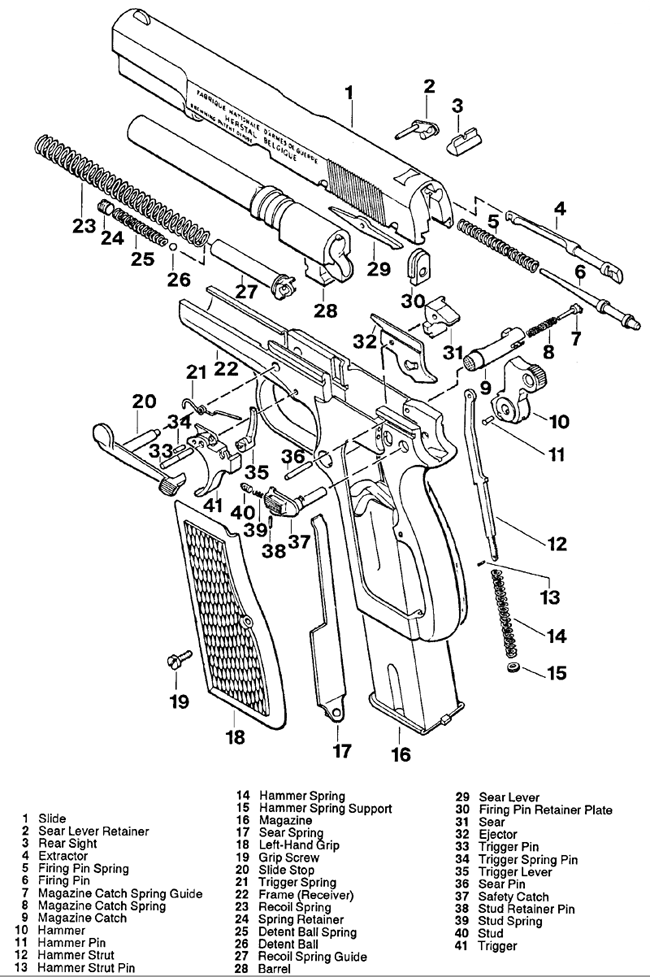 Browning High Power (P-35)
Browning High Power (P-35)
| Length Overall | Barrel Length | Weight | Caliber | Action Type | Magazine capacity |
| 7.75 inches | 4.75 inches | 32 Ounces | 9mm | SA semi auto | 13+1 |
| The Classic Browning |
Current Production |
| Magazines |
Dissasembly and Operation |
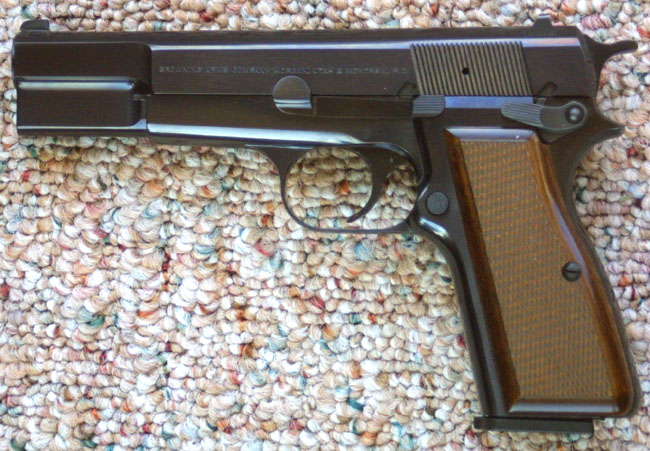 This is one of the world's classic pistols. It was
designed on the eve of the Second World War, and has been found in
almost every conflict since then. Millions of these pistols were made
to arm Great Britain, and the members of the British Commonwealth, during
the Second World War, and beyond. Millions more have been made, though
of considerably higher quality, for civilian shooters since the war. The
Browning High Power, P-35, GP, or whatever you want to call it, is one of
the oldest military pistols still serving. As of this writing, the big
Browning has been in service for just over 70 years, and is as popular
as ever. This is one of those rare cases where something was designed, which
was so nearly perfect, that there was little that could be done by way of
improvement. This is not to say that new offerings were not made.
This is one of the world's classic pistols. It was
designed on the eve of the Second World War, and has been found in
almost every conflict since then. Millions of these pistols were made
to arm Great Britain, and the members of the British Commonwealth, during
the Second World War, and beyond. Millions more have been made, though
of considerably higher quality, for civilian shooters since the war. The
Browning High Power, P-35, GP, or whatever you want to call it, is one of
the oldest military pistols still serving. As of this writing, the big
Browning has been in service for just over 70 years, and is as popular
as ever. This is one of those rare cases where something was designed, which
was so nearly perfect, that there was little that could be done by way of
improvement. This is not to say that new offerings were not made.
This was the last work of true genius from
famed firearms developer John Browning. He had initially thought to
produce a version of his trend setting 1911 pistol, for use by European
powers. This would require rechambering the gun in 9mm. While busily engaged
in re-engineering the gun, Browning made several improvements in the mechanics
of the design. The most important were the replacement of the old under
barrel toggle link, with a cam, and the addition of an integral feed
ramp, with a deletion of the cut out in the chamber. The integral ramp
eliminates much of the concern of jamming with certain bullet shapes.
This has plagued some versions of the older 1911 design. It also allows
the 9mm to have a higher chamber pressure than that of the 45. A number
of minor changes were also made, including the removal of the grip safety,
addition of a magazine safety, and numerous ergonomic changes. One additional
feature, which made this gun stand out among the rest, was the new double
column magazine. Though the term "wonder nine" did not come to exist until
decades after the introduction of the big Browning, this was the prototype
of the breed.
It seems as though Browning achieved near
perfection with this gun. After nearly 70 years of service, this is
still a front line weapon. It has also defied the efforts of
those who would improve upon it, and the gun remains basically the same
today. The only grumblings heard about this pistol, with any frequency,
are complaints about the magazine safety, and the small size of the
thumb safety. Both conditions are easily remedied. Numerous variations
of sights have been tried on this gun from a fixed notch to a flip up
tangent site. The gun has been manufactured, under license, throughout
the free world, and has been copied everywhere else. Where exact copies
have not been made, the mechanics of the gun have been incorporated into
a bewildering number of models. The S&W 59/69 series of pistols has
the double column magazine, and locking system of the Browning, The entire
S&W series of Auto pistols are essentially double action knock offs
of the classic Browning. An interesting note on this, is that the Smith autos
are in something like their fifth generation, and have yet to match the
original design of the P-35. I suspect this says something about the difference
between an inspired design brought about by the efforts of a genius, and
a series of engineering exercises brought about by design and marketing
comities.
The Browning feels good in the hand, very
good, and looks great. The design, unchanged in decades, looks as
if it just came off the drawing board: timeless. The fit and finish
are wonderful, and I rate the trigger as being second only to that
of the beloved 1911 model. The gun is sufficiently accurate, and can
be brought up to match levels; matches have been regularly shot with
them. The 13 round magazine, though no longer impressive as it was decades
ago, is still sufficient, even by today's standards. The gun is also,
if I dare say it, elegant.
Distinguished by it's absence is a
double action trigger system. To many, this is the one thing which dates
the design of this gun. All of the current crop of wonder nines have double
action triggers, but not the Browning. For some, this seems to be a major
deficiency. Many, who love the ergonomics, and quality of the gun, regret
that John Browning designed it before the popularity of the double action
automatic, as if this should have been incorporated into the design. Most
police departments, and many in the market for a defensive handgun, pass
over the classic Browning because of this, but there are others who hold
quite the opposite opinion.
Contrary to what many may think, John Browning could
have designed a double action trigger into this gun, back when it was
first produced, but chose not to. There were a number of double action
auto pistols, including the popular Walther PPK on the market, or in
military use at the time. Browning was certainly aware of these guns,
and familiar with their design and operation. He was also, doubtless,
aware of the new Walther P-38, double action automatic, then in
the design stages. There were also numerous examples of double action
revolvers being produced, so there was certainly no shortage of exposure
to this system. Yet Browning kept to the single action trigger system
on what he meant to be the ultimate refinement of his most inspired design.
Why would he do this?
A version of the P-35 was made, some
years ago, incorporating a double action trigger, but it flopped in
the market, and was withdrawn. Colt had a similar experience with it's
own Double Eagle, another double action version of a classic Browning pistol.
The initial versions of the S&W series of 9mm double action pistols
were not big sellers for years after their introduction. In all of these
cases, the shooting public had made the same choice as John Browning, in
picking single action over double action, and for the same reason. No double
action trigger system yet made, can approach the single action for the crisp,
light pull so conducive to accuracy, and precision shooting. Double action
triggers, even when used in single action mode, are known for creep, slack,
and a heavy pull. There is also, frankly, no reason to have one on an automatic
pistol. A double action trigger, on a revolver, is a useful aid for rapid
fire. In an automatic, it is little more than a detriment to good shooting,
and a crutch for poor gun handling.
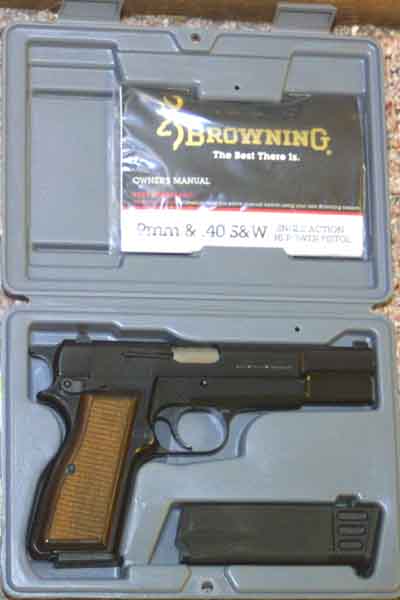 this classic from their line, for a few years, but customer
demand forced it's return. Current production models are available in
traditional 9mm, or the newer 40 S&W. They can be had in blue, nickel,
or stainless steel finishes, and a two tone version is offered. There
is also a match version, complete with longer barrel and adjustable
weights. The production pistols are shipped in a molded plastic case,
fitted to the gun, and include one extra magazine. All of these guns are
assembled in Portugal from parts manufactured in Belgium. Browning has
once again dropped the classic High Power, but it is now being imported
directly from the manufacturer in Belgium.
this classic from their line, for a few years, but customer
demand forced it's return. Current production models are available in
traditional 9mm, or the newer 40 S&W. They can be had in blue, nickel,
or stainless steel finishes, and a two tone version is offered. There
is also a match version, complete with longer barrel and adjustable
weights. The production pistols are shipped in a molded plastic case,
fitted to the gun, and include one extra magazine. All of these guns are
assembled in Portugal from parts manufactured in Belgium. Browning has
once again dropped the classic High Power, but it is now being imported
directly from the manufacturer in Belgium. Unfortunately, the included magazines are, of course, limited to ten rounds. This is for our own protection, naturally, and it is always a comfort to know that my government cares about me, and is always on the lookout for ways to prevent me from hurting myself. The good news is, that the original capacity mags will fit, and can now be found at reasonable prices. The rated capacity of this gun is thirteen rounds, though even Browning admits that it is possible to sometimes load fourteen. Magazines are available from Browning, military surplus, and a variety of third party manufacturers. They have been in more or less constant production for almost seventy years. The high capacity magazine ban expired in 2004, which greatly eased the difficulties of finding a ready supply of full capacity magazines. There is another option available, however. The original magazine design of the Browning was a bit on the conservative side. There is a new design, imported from South Africa, which holds 17 rounds, and fits like a standard magazine. This pretty much brings the capacity of these guns up to the same level as the Glock, and the rest of the current crop of wonder nines.
The fit and finish of the commercial gun is excellent, from the nicely varnished, and intricately checkered grips, to the deep blue-black polish of the metal. There is a mirror like quality, a luster similar to that of my Colt Gold Cup and some of my N frame S&W revolvers. This is in contrast to some of the military models, which have black plastic grips, and are generally Parkerized, lightly blued, or enameled. The enameled finish on some of the military guns is particularly displeasing. Calling the finish enamel, is just a fancy way of saying paint. This has the look of some of the cheap toy guns, and metal cars that I recall from my youth.
A glance at the trigger, somewhat isolated from the frame, might lead one to believe that this is a double action pistol. It is not, though a double action version is, once again, available. Rather than pushing on an action bar, as in the case of the classic 1911, the P-35 pivots to pull on the action bar. This method of operation, along with the addition of a magazine safety, gives the trigger a slight bit of slack. It is not objectionable, and does not compare to the sloppiness found in most of the current crop of double action autos, but it is there, nonetheless. Once the slack is taken up, the trigger breaks very crisply.
Trigger slack aside, this gun is comfortable to shoot, and quite accurate. I can shoot into a couple of inches down at the pistol range. My shots tend to pattern a bit low, and to the left, though this could certainly be improved upon by finding the right loads, and adjusting the sights. My example has the fixed sights, though adjustable, and even tangent sight versions are offered. The fixed sights are ideal for combat use, being low enough not to snag on clothing, but large enough to be visible and relatively easy to use. As with most fixed sights, these are "drift" adjustable, with a mallet.
I have been wanting a "genuine" Browning Hi-Power, since I was about sixteen, but could never justify spending the money, when similar models from S&W, along with offerings from other companies were available. These other guns seemed to be just as capable, while costing quite a bit less than the Browning. Though my first choice would have been the old P-35, cost considerations had me settle for one of the original S&W M-59's, as my first 9mm pistol. While the cost of these other guns has risen dramatically, that of the Browning has only been increased slightly. It is now possible to buy a Browning for little more than the cost of these other guns, making it's purchase a much more viable option. The new models are faithful to the original design, except for the addition of an ambidextrous safety.
This gun has appeared in so many movies that there is no point in even listing them. As one of the most prolifically produced and distributed firearms in the world, it has become as much a standard as the M1911. My first exposure to the P-35 was in the movie 99 and 44/100 percent dead, with Richard Harris. This was an odd offbeat movie, which bombed at the box office, got terrible reviews, and is generally considered to be awful. I actually kind of like the film, and certainly was impressed with the matching set of P-35 pistols, compete with flower carved grips, used by the main character. In addition to Harris, the gun was used in the Indiana Jones movies, and nearly every European W.W.II movie ever made.
The Browning High Power, P-35, GP, or whatever you want to call it, is one of the oldest military pistols still serving. As of this writing, the big Browning has been in service for just over 70 years, and is as popular as ever. This is one of those rare cases where something was designed, which was so nearly perfect, that there was little that could be done by way of improvement. This is not to say that new offerings were not made. This is particularly true in the case of the magazines.
For years, this gun, whatever other virtues it may have possessed, was defined by it's double column magazines. The high capacity magazine was the signature of the big Browning, and was not replicated by any other firearms manufacturer until the introduction of the S&W M-59 in the seventies. The gun was unique, expensive, in widespread use, and an instant classic. The original 13 round magazine was quite a development back in it's day. This was the original detachable double column magazine pistol, and the first to offer a greater than 10 round capacity in a standard pistol. The standard, at the time, was the Colt Government, which held seven rounds, or the German Luger, which held eight. Six shot revolvers were, by far, the most common pistols in use at the time, giving the big Browning twice the capacity of the basic handgun of the day. Interestingly, in light of the fame that it's magazine style conferred upon it, Browning hesitated to use a double column magazine, considering it too unreliable. Today, there are essentially four different standard magazine capacities for the big Browning.
Though the Browning is often credited with the introduction of the double column magazine, this is only partially true. The Browning High Power was the first pistol to use a removable double column magazine; but the Thompson had employed such a design in the twenties, and the German Bergman (MP-18) was modified to use such a magazine, after the end of W.W.I, though neither of these was a pistol. In the realm of the pistol, the 10 round magazines of the old Mauser Broomhandle were nominally of double column design, though they were not detachable. Still, in the modern sense of the design, the Browning P-35 (high Power) introduced the idea of the double column pistol magazine.
The original 13 round magazine, introduced along with the new pistol in 1935, was very conservatively rated, and designed. Most can be made to hold an extra round or two, by a determined user. At the inception of the P-35, the average semi auto held seven or eight rounds, while the traditional revolver held six. Thirteen rounds seemed quite an extravagance at the time; but things change. In 1973, S&W introduced the Model 59, a 9mm pistol which held fifteen rounds. Though not very popular at first, this pistol was ultimately to be the catalyst which would drive the development of what would come to be called, the Wonder Nine. The more recently designed S&W 59 series of automatics is based upon the Browning design, and uses a magazine of the same size, but able to hold fifteen rounds. Today's metallurgy allows for the production of much better springs than those available to Browning in the thirties.
Once realized, the idea of the Wonder Nine began to gain inertia. Nearly every manufacturer came out with it's own model. The U.S. military adopted a double column 9mm, with a 15 round capacity, following a trend already set by the armies of many other nations. police began to drop their trusty revolvers, in favor of the new breed of hi cap automatics. H&K came out with their VP70, which held 20 rounds, while a gas powered pistol called the P-18 held 18 rounds. The extremely popular Glock holds 17 rounds. Suddenly 13 rounds did not seem extravagant at all. Compared to the new crop of wonder nine pistols, a capacity of 13 rounds suddenly seemed a bit quaint.
More recently, slightly more efficient mags have been produced, which permit the old P-35 to rival the capacities of the newest designs. In particular, a series of flush fitting 15 round magazines are on the market, along with a 17 round version with a floor plate which protrudes slightly from the bottom of the magazine well, in the manner of the Glock. There have always been extended magazines available, and common capacities are 20, 25, and 30 rounds. In addition, I have put together a pair of surplus Suomi magazines, which hold 72 rounds, and fit the Browning. Unfortunately the powers of regression have taken magazine design in the other direction, designing a 10 round version for use during the years of the clinton mandate.
Though most experts will tell you that the double column magazine is an answer to a question that was never asked, and that the average gunfight consists of three to five rounds, it is far more confidence inspiring to have seventeen rounds on tap than to have eight. Of course, these same people will also tell you that the average gunfight takes place at seven feet, and rarely outside of twenty feet. Yet I do not hear these people saying that we can thus dispense with the practice of putting sights on handguns.
|
The ten round clinton magazine
The ten round Browning magazine was designed around
the shameful crime bill of 1994, passed during the shameful buffoonery
of the clinton presidency. There are a number of methods available to reduce
the capacity of a magazine. The method chosen by Browning was to shorten
the magazine, and then add a solid plastic extension to the bottom, to
maintain the length of the magazine. Though clinton, a proven perjurer,
traitor, sexual predator, and drug user is now out of the white house that
he so badly disgraced, there is still a large contingent of like minded trash
in federal and local government. Due to this perversion of government, the
subjects of a number of the more poorly run parts of the country are still
limited to the use of these foolishly mutilated magazines, if their rulers
even permit them to own handguns. Thus endeth the tirade. |
|
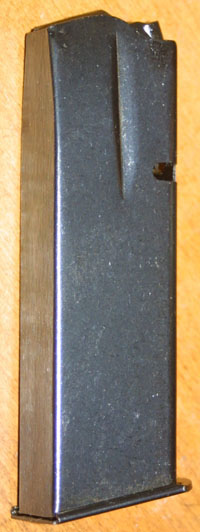
|
The thirteen round standard magazine
The original 13 round magazine was quite a development
back in it's day. This was the original detachable double column magazine
pistol, and the first to offer a greater than 10 round capacity in a
standard pistol. The standard, at the time, was the Colt Government,
which held seven rounds, or the German Luger, which held eight. Six shot
revolvers were, by far, the most common pistols in use at the time, giving
the big Browning twice the capacity of the basic handgun of the day. Interestingly,
in light of the fame that it's magazine style conferred upon it, Browning
was hesitant to use a double column magazine, considering it too unreliable.The magazine is very conservatively rated, by today's standards. In part this is due to the better springs, and metallurgy of today's firearms, and in part due to the 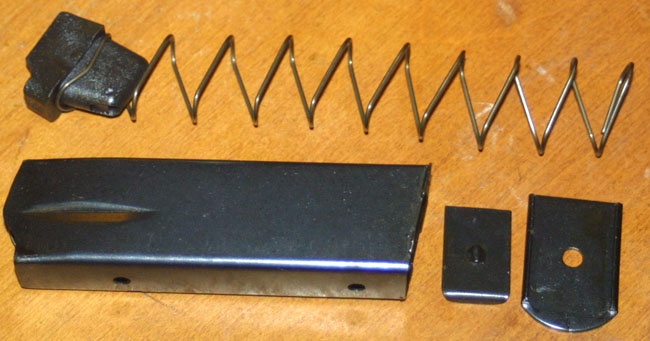 fact that this was a first try of a new concept, and it was not thought
prudent to take things to the limit. In addition, by the standards of
the day, thirteen rounds was thought to be sufficient, if not excessive.
Browning no longer offers this capacity, in a civilian factory magazine;
but surplus magazines are widely available.
fact that this was a first try of a new concept, and it was not thought
prudent to take things to the limit. In addition, by the standards of
the day, thirteen rounds was thought to be sufficient, if not excessive.
Browning no longer offers this capacity, in a civilian factory magazine;
but surplus magazines are widely available. |
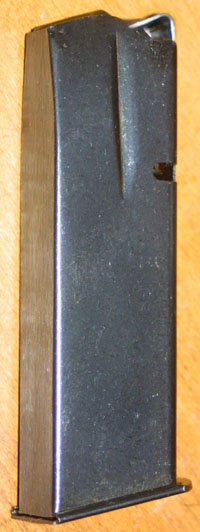
|
The fifteen round, modernized magazine
Mecgar, Ram Line, and a number of other aftermarket magazine companies
offer flush fitting fifteen round magazines for the Browning. These are
essentially modern renditions of the classic Browning magazine, using
redesigned followers to take advantage of today's more modern springs.
That they offer the same capacity as the 9mm S&W series is no coincidence.
This is the capacity that modern materials permit, to a magazine of this
size. Though Browning officially still produces a 13 round magazine for
it's pistols, standing by the original design capacity, most of these magazines
can hold fourteen or fifteen rounds. The original Browning had either a dimpled magazine body, or long follower, to prevent the magazine spring from being compressed and kinked. In some cases, both the magazine body, and follower were designed this way. This permitted only 13 rounds to be loaded, though some contract magazines were abel to take a round or two extra. In some cases, this is handy; but most of the time, overloading such a magazine will eventually ruin the springs, and cause the gun to jam. |
|
The new 17 round magazine
These are presently, the most expensive aftermarket magazines you can buy, because of their high capacity; but they are not the best made. There is no floor plate, and the plastic base is unlikely to be as durable as the common metal bases found on the standard capacity magazines. There is no lock on the base, so that disassembly requires snapping the base out, and then snapping it back in, past a pair of detents. |
|

|
Extended magazines
Lastly, there are the extended magazines. Generally
the term extended refers to the fact that these are designed for extended
firing, though it may also be interpreted to acknowledge the fact that
these magazines all extend past the butt of the firearm. The first of these
was designed for the Colt Government pistol, and was issued to flyers early
in the First World War, for use against other aircraft. For the Browning
these are most widely used in capacities of twenty to thirty rounds. They
are, frankly, pretty stupid; but they have the virtue of being cheap, often
costing less than the standard capacity magazines. They make the gun handle
and balance oddly, are heavy, delicate, and can compromise the ability to
seek low cover. I don't even need to mention the silliness of trying to
holster a gun with such a magazine. I do own a few; but do not really see
much use for them.A better choice might be a drum magazine; but really, if you are looking for this kind of fire power, you should probably be using a rifle. In point of fact, carbine use is what this type of magazine was designed for. Still, I would choose a drum, like the Suomi shown below, rather than an extended stick. |
|
The suomi Drum
It is possible to modify the pervasive Suomi drum
magazine to fit a number of 9mm handguns. One of these is the Browning High
Power. The Suomi drum holds 72 rounds. the drum is larger and heavier than
the extended magazine; but is a bit less silly. |
|
Most of us don't give much thought to the humble magazine. In some cases, this motivates us to buy magazines which are, perhaps, more humble than ought to be the case. There are a number of firearms enthusiasts who will spend lavishly on a high quality handgun, and then skulk around gun shows, searching for the cheapest aftermarket magazines obtainable. This is further exacerbated, when the arm in question is a military arm, in which case large numbers of contract magazines may be available. Such is the case with, in particular, the M1911, and the Browning P-35.
In practice, magazines for the Browning vary from wonderful to dismal. Some are finely crafted, and precisely dimensioned parts, while others are junk, stamped out with all of the care, of a soft drink can. These differences are equally obvious on the internals, such as the springs, and followers. The springs can be weak, or may not last for very long, the followers may be made of plastic, or cheaply stamped out and poorly shaped. The insides of the magazine bodies may be rough, or perhaps a bit uneven. Economizing, in this manner, makes about as much sense as buying a nice Ferrari, or Porsche, and then getting the cheapest balloon tires, preferably used, that will fit.
| Disassembly, of the P-35 is similar to
that of the classic M1911; but is somewhat simplified. As with all Browning
derived designs, you must first remove the magazine, and lock back the slide. |
|
| Pull the slide back, just s touch more,
and push the thumb safety up, into the disassembly notch. This will make
it easy to remove the slide stop. |
|
| Push the slide stop, from the right side
of the frame. You will need to push it up, a bit, to clear. The slide stop
may then be removed, from the left side of the frame. |
|
| While taking care to hang on to the slide,
push the safety down, out of the disassembly notch. |
|
| The slide may now be pulled forward,
off of the frame. |
|
| Pushing forward slightly on the recoil
spring, will allow it to be lifted off of the barrel. |
|
| The barrel may now be pushed forward slightly,
and lifted from the slide. |
|
| The Browning Hi-Power (P-35), disassembled
for cleaning. |
